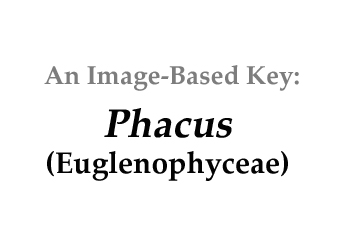|
|
|
|||
|
|
||||
|
Click on images for larger format |
||||
Name derivation: |
||||
|
“Lens” or “Seed” -- Phakos |
||||
Classification: |
||||
Phacus Dujardin 1841; 145 of 553 species descriptions are currently accepted taxonomically (Guiry and Guiry 2013).Synonym: Cryptoglena Ehrenberg 1832 (similarity to Phacus is based on recent electron microscope studies by Rosowski and Lee (1978).Order Euglenales; Family Phacaceae |
||||
Morphology: |
||||
|
Free swimming flattened green unicell with one emergent flagellum. The pellicle is rigid, thus the cell does not exhibit metaboly (‘euglenoid movement - a form of motion characteristic of euglenoids). Many small discoid chloroplasts. Cell shape is ‘leaf-like’ in most species. Edges of protein strips of pellicle forming striations or grooves are evident, often lying parallel to cell edges or in an S-helix (Leedale 1967). |
||||
Similar genera: |
||||
Habitat: |
||||
|
Planktonic in eutrophic freshwater ponds. Tend to be most abundant in nutrient-rich basins, including sewage treatment lagoons. |
||||
References: |
||||
|
Ehrenberg, C.G. 1832. Über die Entwickelung und Lebensdauer der Infusionsthiere; nebst ferneren Beiträgen zu einer Vergleichung ihrer organischen Systeme. Abhandlungen der Königlichen Akademie Wissenschaften zu Berlin, Physikalische Klasse 1831: 1-154, pls I-IV. Graham, L., and L. Wilcox 2000. Algae. Prentice-Hall Guiry, M.D. and Guiry, G.M. 2013. AlgaeBase. World-wide electronic publication, National University of Ireland, Galway. http://www.algaebase.org; searched on 25 February 2013. Leedale, G. F. 1967. Euglenoid flagellates. Prentice-Hall
|
||||






